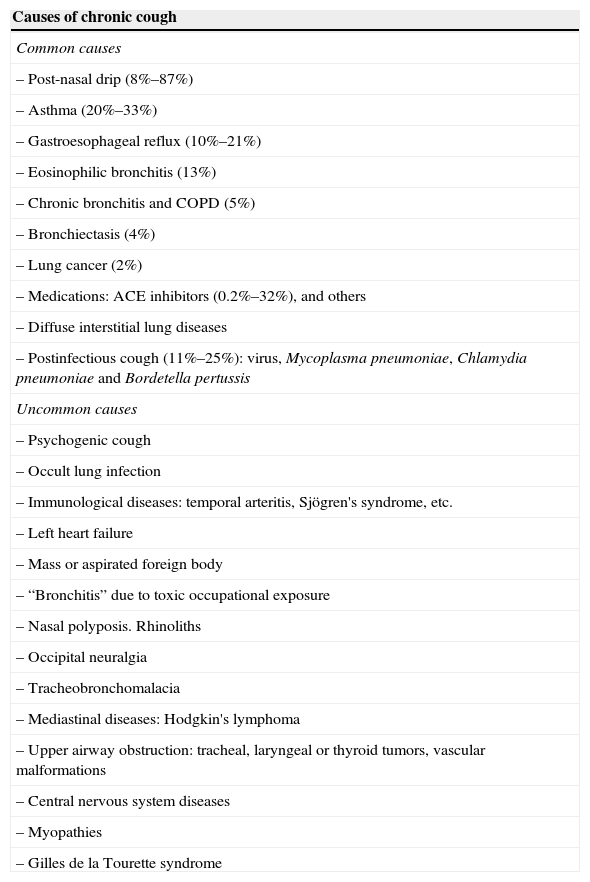Although cough following pertussis infection is one of the causes of chronic cough1 (Table 1), this entity is rarely suspected in adults. Recent data, however, show that pertussis control is failing, and outbreaks2 affecting adults are being reported, due to gradual loss of the immunity acquired with childhood vaccination. We report the case of a 40-year-old woman with persistent cough who was referred to a specialized asthma clinic where the final diagnosis of pertussis was made.
Causes of Chronic Cough.
| Causes of chronic cough |
|---|
| Common causes |
| – Post-nasal drip (8%–87%) |
| – Asthma (20%–33%) |
| – Gastroesophageal reflux (10%–21%) |
| – Eosinophilic bronchitis (13%) |
| – Chronic bronchitis and COPD (5%) |
| – Bronchiectasis (4%) |
| – Lung cancer (2%) |
| – Medications: ACE inhibitors (0.2%–32%), and others |
| – Diffuse interstitial lung diseases |
| – Postinfectious cough (11%–25%): virus, Mycoplasma pneumoniae, Chlamydia pneumoniae and Bordetella pertussis |
| Uncommon causes |
| – Psychogenic cough |
| – Occult lung infection |
| – Immunological diseases: temporal arteritis, Sjögren's syndrome, etc. |
| – Left heart failure |
| – Mass or aspirated foreign body |
| – “Bronchitis” due to toxic occupational exposure |
| – Nasal polyposis. Rhinoliths |
| – Occipital neuralgia |
| – Tracheobronchomalacia |
| – Mediastinal diseases: Hodgkin's lymphoma |
| – Upper airway obstruction: tracheal, laryngeal or thyroid tumors, vascular malformations |
| – Central nervous system diseases |
| – Myopathies |
| – Gilles de la Tourette syndrome |
This was a 40-year-old woman, with no toxic habits and no routine medication. Her only disease history was squamous cell carcinoma of the buccal mucosa treated with radiation therapy administered to the right side of the face and neck 2 years previously. Response was complete. On this occasion, she presented dry cough, post-nasal drip and rhinorrhea that were treated with azithromycin, antihistamines and nasal corticosteroids, with mild initial improvement. One week later, however, the cough increased and she had her first attack of convulsive cough with laryngeal spasm. Episodes of paroxysmal cough increased in frequency until they occurred daily, with sudden onset, predominantly at night. She was assessed by the eye, nose and throat (ENT) specialist, who ruled out ENT disease and referred the patient to the asthma clinic. The patient was prescribed inhaled and systemic corticosteroids, with no improvement. Chest X-ray and lung function test results were normal, and the bronchodilator test was negative with oral exhalation of nitric oxide levels of 5ppb. Laboratory tests revealed 13300 leukocytes/mm3 with 77% neutrophils. Pertussis was suspected clinically, so a culture of pharyngeal exudate for Bordetella pertussis was requested, for which genomic detection was positive. Diagnosis was confirmed 9 weeks after onset of clinical symptoms. All treatment was discontinued, and the patient's cough abated gradually, until it was completely resolved. Her vaccination calendar was reviewed, showing that she had received 3 doses of the diphtheria-tetanus-pertussis (DTP) vaccine at age 10, 11 and 16 months, and 2 booster doses at 3 and 13 years.
Pertussis is a highly contagious acute respiratory infection of the upper respiratory tract caused by the bacteria Bordetella pertussis. It is characterized by episodes of highly limiting violent coughing, occasionally accompanied by whooping on inspiration. Humans are the only known reservoir of infection and the mechanism of transmission is direct contact with secretions from infected respiratory mucosa. After incubation (7–10 days) and a catarrhal period with non-specific symptoms (1–2 weeks), the paroxysmal phase begins (2–4 weeks) with convulsive cough followed by deep inspiration against a closed glottis at the end of the paroxysm, which produces the typical whoop. It gradually resolves after 3 months, but the incidence of residual cough in adults can be as high as 50%.3 In these patients, clinical symptoms are more latent: cough is severe and prolonged, mainly at night, and less paroxysmal than in children,4 which contributes to underdiagnosis. In our case, the diagnostic delay was considerable: asthma was suspected and the patient even received treatment with oral corticosteroids. It is our opinion, then, that pulmonologists should not overlook pertussis in patients with persistent cough. Once suspected, diagnosis is simple. Nasopharyngeal culture is the most specific technique, but sensitivity is low (50%–70%) so other molecular biology techniques that also offer the possibility of rapid diagnosis2 are recommended for achieving greater sensitivity (70%–99%).
Please cite this article as: Cepeda S, Martínez Moragón E, Ponce S. Tos ferina del adulto: una enfermedad emergente en la consulta del neumólogo. Arch Bronconeumol. 2015;51:472–473.










